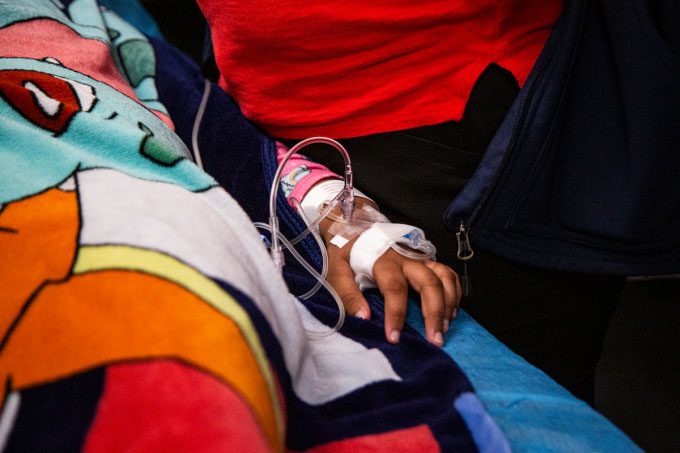The World Health Organization (WHO) has reported 10 million cases of dengue fever in the first half of this year, a “record unprecedented” with over 16,000 severe cases and 3,000 fatalities.
This number is three times higher than the same period in 2023, highlighting the danger of the outbreak, according to the WHO. There is a significant increase in the Americas, where the number of infected individuals exceeded 7 million by the end of April.
Genesis Polanco Marte, a 9-year-old girl, arrived at the emergency room of a hospital in the United States with symptoms of fever, body aches, and dehydration. She appeared pale and lethargic, continuously uncomfortable as a pediatrician stroked her hair and spoke to her in Spanish. Test results showed that Marte was one of the 10 million people infected with dengue fever – an unprecedented outbreak linked to climate change, according to scientists.
This disease is common in Southeast Asia but is often overlooked by Western countries. Rising global temperatures have accelerated the life cycle and range of the virus-carrying mosquitoes. Statistics indicate that one in every 800 people has contracted dengue fever in the first six months of the year.
The large number of patients has overwhelmed hospitals from Brazil to Bangladesh, reminiscent of the worst days of the COVID-19 pandemic. Puerto Rico declared a public health emergency in the spring, with more cases reported than the previous year. Health officials are preparing for the possibility of the virus appearing in temperate regions, including South America.
“The dengue fever storm is coming. It is currently active in Puerto Rico but will soon spread more aggressively.” Grayson Brown, executive director of the Puerto Rico Mosquito Control Unit, stated.
Last week, the Centers for Disease Control and Prevention (CDC) in the United States warned of the increasing risk of dengue fever and urged doctors to remain vigilant regarding the disease. However, despite the record rise in cases, it remains one of the most neglected diseases, according to the WHO. Three out of four cases display mild or no symptoms, making it difficult to track.
The dengue virus has four serotypes, which means previous natural infections do not provide immunity for the future. Another factor that makes dengue fever dangerous is the severe complications that occur when a patient is infected with two different strains of the virus sequentially.
Currently, there is no specific treatment for dengue fever. Severe cases can lead to plasma leakage from blood vessels, internal bleeding, multiple organ failure, and death.
Experts consider the crisis in Puerto Rico a warning sign for the rest of the world and the United States. It demonstrates how quickly an outbreak can spread in communities with weak healthcare infrastructure amid rising global temperatures. Research shows that without decisive action, approximately 2 billion people are at risk of contracting dengue fever in the next 50 years.

Genesis Polanco Marte, 9 years old, being treated for dengue fever at Auxilio Mutuo Hospital in San Juan, Puerto Rico, on May 30. (Photo: Washington Post).
Climate Change is a Threat
Public health officials in Puerto Rico are preparing for a scenario of skyrocketing infection rates as the island enters the hot and rainy season. In mid-June, the region reported over 1,500 cases, with at least two fatalities.
Hot and stormy weather is ideal for the Aedes aegypti mosquito, the vector for dengue fever. Unlike malaria-carrying mosquitoes (which need to bite a person only once before laying eggs), Aedes aegypti mosquitoes move from person to person, increasing the likelihood of disease transmission with every bite.
In densely populated urban areas of Puerto Rico, most families cannot afford air conditioning, so they keep cool by opening windows and doors without mosquito screens.
Meanwhile, global warming is creating a serious outbreak. Greenhouse gas emissions, primarily from the burning of fossil fuels, have raised average temperatures in the region since 1950, according to the National Climate Information Center. This change is favorable for Aedes aegypti mosquitoes. Scientists have found that warmer conditions can cause this insect to grow rapidly, bite more people, and lay more eggs. Higher temperatures also make the dengue virus more infectious, allowing it to multiply quickly in hosts.
Officials are concerned that elevated temperatures will facilitate outbreaks in the United States. Gabriela Paz-Bailey, director of the CDC’s dengue branch in Puerto Rico, stated: “Even a single case in an area that does not typically experience dengue fever consumes significant resources, raising public concern.”
In tropical regions across Latin America, Africa, and Asia, dengue fever primarily circulates during the summer months. However, warming weather is causing the disease to extend year-round. Additionally, climate change is allowing the virus to penetrate temperate regions and highland communities. Nepal, which had never reported a case before 2004, witnessed over 50,000 cases in the past year.
In Vietnam, in the first three months of this year, Hanoi reported 513 cases of dengue fever, a threefold increase compared to the same period last year.

Health workers are killing mosquitoes at an elementary school in Puerto Rico. (Photo: Washington Post).
Challenges in Vaccination
In reality, the dengue virus has many serotypes, with unusual mechanisms that cause severe illness, making treatment and prevention particularly challenging. Infection with one strain of the virus can create antibodies against future infections. However, similar antibodies can bind to a virus of a different serotype, facilitating their entry and causing more severe illness.
Dengvaxia is the only vaccine approved in the United States, protecting children against all four dengue serotypes. However, the condition for vaccination is that the child must have been previously infected.
In Puerto Rico, very few people are aware of Dengvaxia. Vaccination efforts are slow, with many parents unaware of the dangers posed by dengue fever. After the pandemic, they have grown tired of hearing more about vaccination.
According to the CDC, only 145 children in Puerto Rico began vaccination since Dengvaxia became effective in 2022, a very small number compared to the 140,000 children eligible.
Now, access to the vaccine is even lower. A few months before Puerto Rico declared a public health emergency, the pharmaceutical company Sanofi announced it would stop producing Dengvaxia due to low demand. The last doses are set to expire in August 2026.
In May, several countries, including Argentina, Brazil, Colombia, and Indonesia, approved a second vaccine named Qdenga. Developed by Japan’s Takeda, this vaccine is recommended by the WHO for children aged 6 to 16 years, requiring only two doses and can be used regardless of previous infection status. However, the company withdrew its application from the Food and Drug Administration in July 2023 due to data collection issues.
The U.S. National Institutes of Health (NIH) is developing a third vaccine, expected to take at least another year.
In Vietnam, in May, the Drug Administration under the Ministry of Health approved the Qdenga dengue vaccine. The vaccine is over 80% effective and is intended for children aged 4 years and older. The vaccination schedule consists of two doses spaced three months apart.



















































